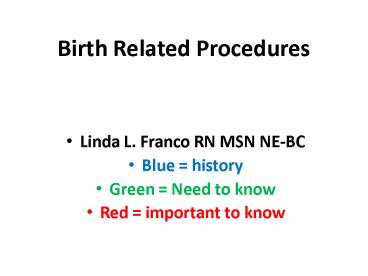Birth Related Procedures PowerPoint PPT Presentation
Title: Birth Related Procedures
1
Birth Related Procedures
- Linda L. Franco RN MSN NE-BC
- Blue history
- Green Need to know
- Red important to know
2
Version (turning of the fetus)
- Methods
- External
- External cephalic version (ECV) fetus is changed
from breech to cephalic thru external measures - Internal
- Rarely used, occurs when the 2nd fetus during a
vaginal twin birth isnt doing well. Med is given
to relax uterus and dr reaches in and pulls the
fetus out. Usually the woman is given a c-section - Risks
- Hypoxia
- Fetal Distress
- Abruptio Placentae
3
Criteria for External Version
- Must be at least 36 or more weeks gestation
- Must have a Reactive NST immediately prior
- Fetal breech is not engaged
- So if they baby is breech and is not engaged (or
dropped)
4
Contraindications for Version
- Maternal problems
- Uterine anomalies, uncontrolled PIH (pregnancy
induced hypertension), third trimester bleeding - Make sure the mom has IV access for meds or blood
or whatever - Complications of pregnancy
- ROM, oligohydramnios, polyhydramnios, placenta
previa - Previous C/S or uterine surgery
- Multiple gestation
- Nonreassuring FHR
- IUGR
5
Amniotomy
- Defined as Artificial rupture of the amniotic
membrane - Need 2 cm of dilation
- Indications
- Induce labor
- Internal monitoring
- Risks
- Infection
- Prolapse of cord
- Abruptio placentae
6
Cervical Ripening
- Soften the cervix
- Cervical readiness is the most important thing
when thinking about inducing labor in a mom - Successful induction
- Management of intrauterine fetal death
- Drugs Prostaglandins, Cytotec
7
Induction Augmentation of Labor
- Indicated health of mother baby
- Elective convenience
- Risks
- Hypertonic uterine activity
- Uterine rupture
- Water intoxication
- Retention of water with sodium depletion. Pt is
lethargic, nauseated, vomiting, and in severe
cases may convulse or go into coma - Antidiuretic effect of oxytocin decreases water
exchange in the kidney and reduces urinary output
leading to fluid overload
8
Induction con.
- Amniotomy
- Cervical Ripening (or readiness)
- Bishop score of 8 or 9
- Table 23-1 1 pg. 540
- The higher the score the more likely it is that
labor will occur - Cervical readiness is the most important criteria
for labor induction - Natural methods sexual intercourse, breast
stimulation, enemas, castor oil - Drugs
- Oxytocin
- Prostaglandins
- Oxytocin Administration
- Secondary IV
- Infusion started slowly
- Contractions q 2-3 min with relaxation between
9
Bishop Scoring System
10
Oxytocin Infusion
- RL 1,000 ml with 10 - 20 units pitocin infuse at
1-2 mu/min - Observe fetal response
- Observe for uterine hypertonus
- Nursing actions
- Stop Pitocin
- Increase primary IV rate
- Turn to left side
- Give Oxygen
- Notify physician
- You want stable contractions every 2-3 mins that
last 40-60 seconds, this is why we give pitocin - Risk of pitocin is hyperstimulation of the
uterus. If this happens we must discontinue the
pitocin. If you dont then placenta perfusion
isnt taking place and the baby isnt getting
oxygen
11
PITOCIN INFUSION CALCUALTION 20 u pitocin
(dont need to know for exam)
- 1000ml x 2mu x 1u x 60min 6ml
- 20u min 1000mu 1hr
hr - 1000ml x 1mu x 1u x 60min 3ml
- 20u min 1000mu 1hr
hr
12
PITOCIN INFUSION CALCUALTION 10u pitocin (dont
need to know for exam)
- 1000ml x 2mu x 1u x 60min 12ml
- 10u min 1000mu 1hr
hr - 1000ml x 1mu x 1u x 60min 6ml
- 10u min 1000mu 1hr
hr
13
Amnioinfusion
- Infusion of warmed sterile Normal saline into the
uterus through an IUPC (intrauterine pressure
catheter) - If the moms bag of water isnt enough then we
put more fluid in there. Helps the baby move
around. - May also be used to dilute miconium (sp?) if the
infant inhales the miconium and its not diluted
they can inhale it, which is bad - Indications
- Oligohydramnios, relieve cord compression, dilute
meconium stained amniotic fluid
14
Episiotomy
- Surgical incision of the perineum
- Indications
- Decrease pressure on fetal head
- Control direction of extension of the vaginal
opening - Clean incision easier to repair and heals better
- Cuts by the dr heal faster than if they rip on
their own - Risks
- Infection
- Kind of makes it more likely to have an anal
sphincter tear - Nursing care
- Ice to perineum
- Observe for edema, hematoma, redness
- Controversial
15
Forceps Assisted Birth
- Metal Instruments shaped to grasp fetal head
- Indications
- Shorten second stage of labor
- Any condition that threatens the mother or baby
that will be relieved with birth - Regional anesthesia has effected the moms motor
functions like they are too drugged to push - Risks
- Vaginal laceration or hematoma
- Trauma to babys face or scalp
- Intracranial or subgaleal hemorrhage
16
Forceps Assisted Birth
17
Vacuum Extraction
- Suction to help deliver fetal head
- Risks
- Cephalhematoma
- Hyperbilirubinemia
- Because of bruising
- Intracranial hemorrhage
18
Vacuum Extraction
19
Cesarean Section
- Incision in abdominal and uterine walls
- Indications
- Complete placenta previa or abruption
- CPD
- Malpresentations
- Herpes active lesions
- Fetal distress
- Chronic Maternal Disease
- Previous C/S
20
Cesarean Section con.
- Risks
- Anesthesia
- Infection
- Hemorrhage
- Trauma to baby
- Procedure
- Skin incision
- Cut into the uterus
- Transverse is usually low and invisible once
healed, takes longer - Vertical is better, used when baby needs to be
out quick - Uterine incision
21
Vaginal Birth After CesareanVBAC
- Low transverse uterine incision
- Contraindication with vertical uterine incision
- Risks
- Hemorrhage
- Uterine Rupture
- Hysterectomy
- Infant death
- Neurological complications

